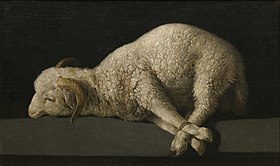Agnus Dei (Zurbarán)

Agnus Dei, by Francisco de Zurbarán. 38 cm × 62 cm. Oil on canvas. Museo del Prado, Madrid
Lamb of God (in Latin, Agnus Dei) is an oil painting completed between 1635 and 1640 by the Spanish Baroque artist Francisco de Zurbarán. It is housed in the Prado Museum in Madrid, Spain.
The Lamb of God is an allusion to Christ's title as recorded in John's Gospel (John 1: 29) when John the Baptist describes Jesus as "The Lamb of God who takes away the sin of the World".[1]
The painting appears in Sarah Phelps' BBC Agatha Christie "quintet", And Then There Were None, The Witness for The Prosecution, Ordeal by Innocence, The ABC Murders, and The Pale Horse. Its repeated use is to symbolise the trussed nature of the guilty character who has put himself on the path to perdition.[2]
References[]
- ^ "Agnus Dei". Museo Nacional del Prado. Retrieved May 24, 2012.
- ^ "The Pale Horse writer Sarah Phelps reveals the painting she's hidden in every single Agatha Christie drama".
External links[]
- Zurbarán, an exhibition catalog from The Metropolitan Museum of Art (fully available online as PDF), which contains material on this painting (see index)
Categories:
- 1630s paintings
- Sheep in art
- Paintings based on the Gospels
- Paintings by Francisco de Zurbarán in the Museo del Prado
- 17th-century painting stubs